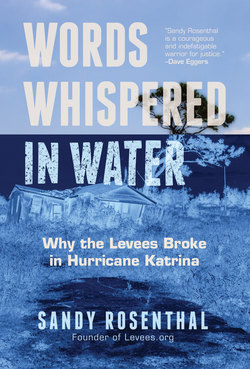Читать книгу Words Whispered in Water - Sandy Rosenthal - Страница 7
На сайте Литреса книга снята с продажи.
ОглавлениеPrologue
Just before the eye passed east of New Orleans, a hurricane surge entered the 17th Street Canal, the largest drainage canal in the city. Floodwalls groaned against the surge’s weight despite supporting steel pilings anchored into thick, earthen levees. The mighty 17th Street Canal could move nearly 10,000 cubic feet of water per second, enough to drain an Olympic-size swimming pool every nine seconds.
But, on this particular Monday morning (August 29, 2005), something was wrong. A section of the floodwall atop the levee had begun to tilt. The steel pilings were too short, and water was flowing into the open gap. The entire section of the floodwall and the levee slid sideways, unleashing a furious blast of briny water into the nearby (mainly white) neighborhood of homeowners.
Eighteen years earlier, the Army Corps of Engineers (Army Corps) had decided that driving steel pilings deeper than sixteen feet was a waste of money.1 Originally, the design for the canal’s proposed new floodwalls had called for expensive steel pilings driven forty-six feet into the ground. But the agency was behind schedule, and costs were rising. In response, the Army Corps conducted a large-scale test study to find ways to save money on steel.
Tragically, they missed a warning sign.
During the test study, when the steel pilings were subjected to a test water surge, they had tilted. No one noticed the menacing tilt because the pilings were underneath a tarp. As a result, the engineers determined that they needed to drive down the steel pilings only sixteen feet instead of forty-six. The Army Corps used this alternate engineering rule for new floodwalls on the 17th Street Canal and several other canals across the city. The new rule saved the Army Corps a total of $100 million.2
In 2000, new floodwalls were installed, but they were destined to fail.
When they collapsed five years later—at a fraction of the water pressure they were designed to contain—hundreds died instantly and thousands more died within months. New Orleans was devastated to the tune of well over twenty-seven billion dollars because floodwalls were not correctly designed and built by the Army Corps.3
At 7:08 p.m., EST the day after the floodwalls broke (August 30, 2005), the Army Corps went into full-time, damage-control mode. Its spokespersons told big media outlets that the hurricane storm surge was just too great. Water had flowed over the 17th Street Canal’s floodwall and caused it to collapse.4 Their story over the course of the next two years would be that nature caused the destruction of New Orleans and New Orleanians themselves were responsible for their loss and suffering due to their own stupidity (they live below sea level) and sloth (the local levee officials were lazy). The Army Corps’ primary mission had become rewriting history and duping the American people.
They almost got away with it.
